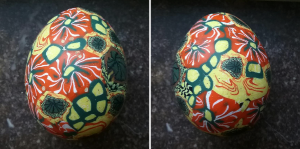This tiny flower and leaves polymer clay cane decorated egg can be made to your order. Your flower petals in the flower cane custom decorated egg. I think this is a fun style of decorated egg.

Month: February 2019
A little snake egg
I used a recipe for cornstarch and baking soda clay to create an egg shape (small) and wanted to try the method of dissolving out the base egg after the p olymer clay was cured. I found it very difficult to dissolve out the base clay using a very small hole in the bottom of this one inch egg…. and in the process, broke it into several pieces…. but love’s labor NOT lost, it looked like something could be created (hence this little snake) that would emerge from the broken egg. A little face only a mother snake could love (LOL).
The tiny broken egg itself I patched with liquid polymer clay (one can still see a tiny seam), then used polymer clay to weight the bottom of the egg to balance the weight of the snake. You can buy an egg like this HERE.

Orange and green flower and leaves decorated egg
It is interesting to me to see how long it has taken to really enjoy making polymer clay canes. I get ideas and they rarely come out as I intend them, but sometimes what I intend is less interesting than what ends up working out. Here is an orange and green floral decorated egg.
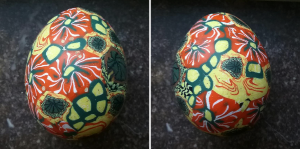
And from similar types of canes comes this egg.

Basal keratinocyte looking polymer clay cane egg: fun histology
After I made this egg with a cane made with alternating brown and cream spikes around the outside of the flower (which even had a dark center like the nucleus of a cell) I laughed at how this egg resembled an histological section parallel to the basal keratinocytes of the epidermis, each cell (each slice of the polymer clay cane) repleate with nuclei and little color bits for organelles surrounded by what looked to me like nice desmosomes, connecting each and every cell (cane slice). Haha, this inspires me to make more eggs from the patterns in bology. Purchase a similar egg made to order HERE.

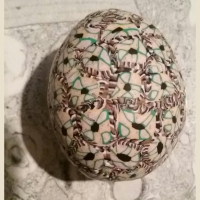
Red black and white polymer clay decorated chicken eggs
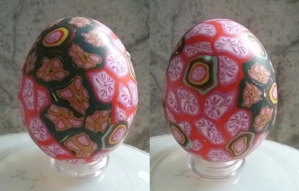

Polymer clay decorated eggs made as keepsakes
This egg is mostly red and yellow with a flower cane pattern and rose petals embedded (these rose petals were from a funeral).
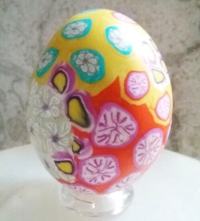

Summary of decorated eggs for sale: polymer clay and keepsake flower petals
These eggs (either exactly if i have not sold them, or similar created with your flower petals) or something entirely new are available for purchase — link to http://memory-beads.com with image.

Two more polymer clay cane decorated eggs
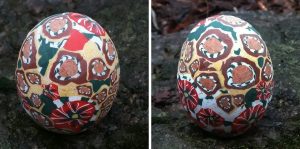
Orange flower polymer clay cane egg
This was a fun and quick polymer clay covered chicken egg to make. I enjoyed it because of the contrast between the orange and deep green. I also find the abstract iterations of the various canes at different sizes. This probably reflects my dislike of rigid repeats (kind of like the machine made precise stuff) and the orderly-chaos creats opportunity for “finding” the slightly different stretches, squashed and reduced repeats. These polymer clay cane eggs are practice for the 10 (well, i broke one, so now 9) ostrich eggs I purchased for this purpose.
